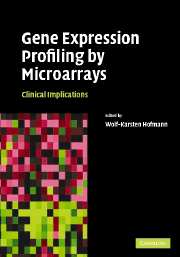Book contents
- Frontmatter
- Contents
- List of contributors
- Foreword
- Introduction
- 1 Technique of microarrays: microarray platforms
- 2 Quantitative quality control of microarray experiments: toward accurate gene expression measurements
- 3 Statistical analysis of gene expression data
- 4 Genomic stratification in patients with heart failure
- 5 Gene expression profiling for the diagnosis of acute leukemias
- 6 Gene expression profiling can distinguish tumor subclasses of breast carcinomas
- 7 Gene expression profiling in lymphoid malignancies
- 8 mRNA profiling of pancreatic beta-cells: investigating mechanisms of diabetes
- 9 Prediction of response and resistance to treatment by gene expression profiling
- Index
- References
5 - Gene expression profiling for the diagnosis of acute leukemias
Published online by Cambridge University Press: 05 September 2009
- Frontmatter
- Contents
- List of contributors
- Foreword
- Introduction
- 1 Technique of microarrays: microarray platforms
- 2 Quantitative quality control of microarray experiments: toward accurate gene expression measurements
- 3 Statistical analysis of gene expression data
- 4 Genomic stratification in patients with heart failure
- 5 Gene expression profiling for the diagnosis of acute leukemias
- 6 Gene expression profiling can distinguish tumor subclasses of breast carcinomas
- 7 Gene expression profiling in lymphoid malignancies
- 8 mRNA profiling of pancreatic beta-cells: investigating mechanisms of diabetes
- 9 Prediction of response and resistance to treatment by gene expression profiling
- Index
- References
Summary
Introduction
Malignant diseases are diagnosed and classified based on cytologic and histologic findings. In particular, acute leukemias are identified based on the cytomorphologic examination of peripheral blood smears and bone marrow aspirates supplemented by cytochemical parameters such as myeloperoxidase (MPO) and non-specific esterase (NSE). Additional diagnostic methods include multiparameter immunophenotyping, which enables a lineage-assignment and a subclassification according to the maturational stage, as well as cytogenetics, supplemented by fluorescence in situ hybridization (FISH), and polymerase chain reaction (PCR). These latter methods have provided deep insights into the biology of different acute leukemia entities. Disease-specific chromosomal aberrations and molecular alterations have been identified for a variety of leukemia subtypes. As a consequence, modern diagnostics in acute leukemias include these methods in combination to allow an optimum characterization of the respective disease. An algorithm for a variety of diagnostic questions using these methods in varying combinations is helpful in order to gather all relevant information in an effective way [1]. Progress in acute leukemia research not only includes the identification and characterization of biologic subgroups. Application of different methods now also allows the selection of disease-specific therapeutic approaches, e.g., the use of all-trans retinoic acid in acute promyelocytic leukemia [2] or the early application of allogeneic transplantation strategies in AML with complex aberrant karyotypes. The significant efficacy of imatinib in BCR-ABL-positive ALL and CML patients, and the use of specific antibodies against CD 20 or CD52, demonstrates the impressive advances in developing tailored disease-specific therapeutic approaches, based on a molecular rationale [3].
Information
- Type
- Chapter
- Information
- Gene Expression Profiling by MicroarraysClinical Implications, pp. 106 - 131Publisher: Cambridge University PressPrint publication year: 2006
